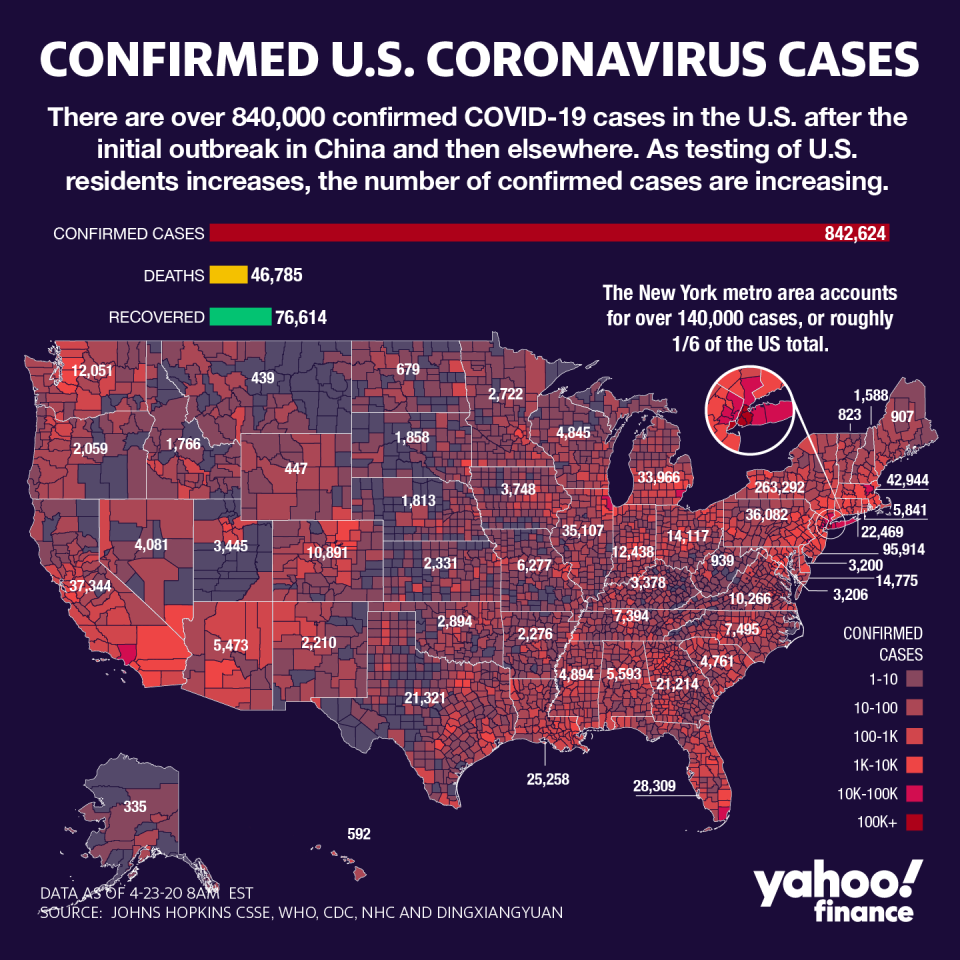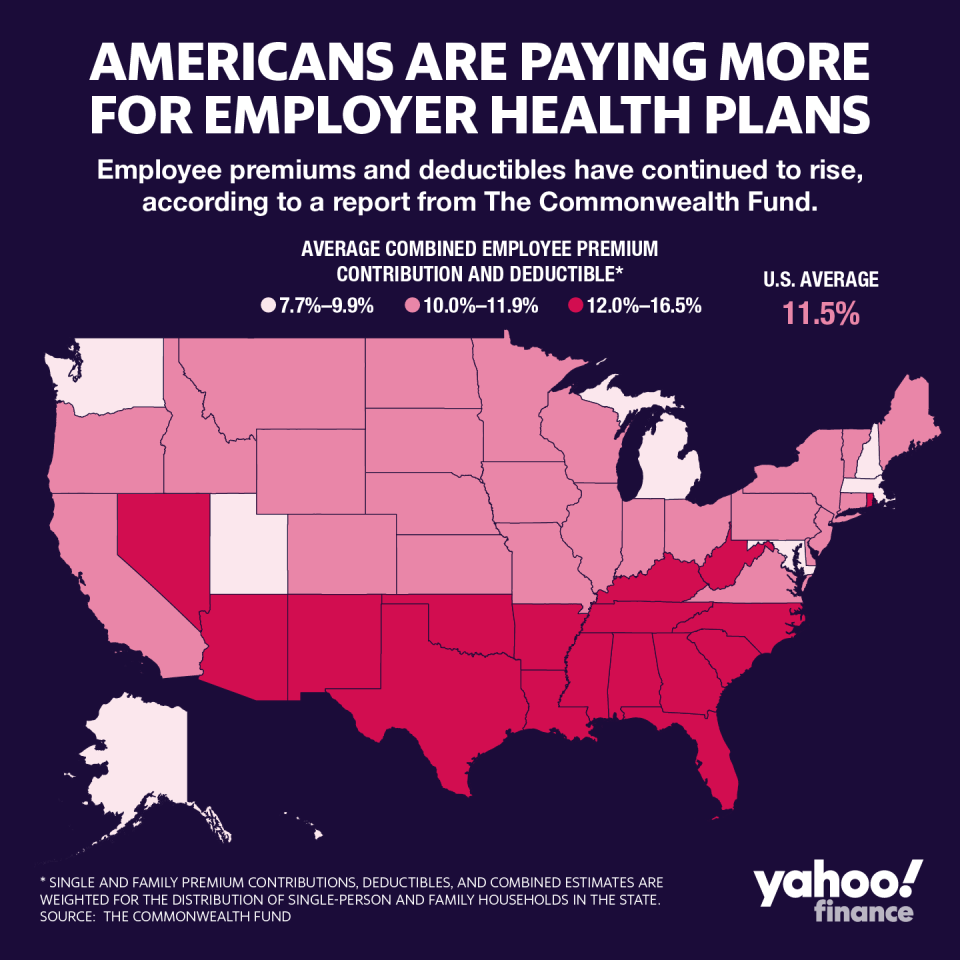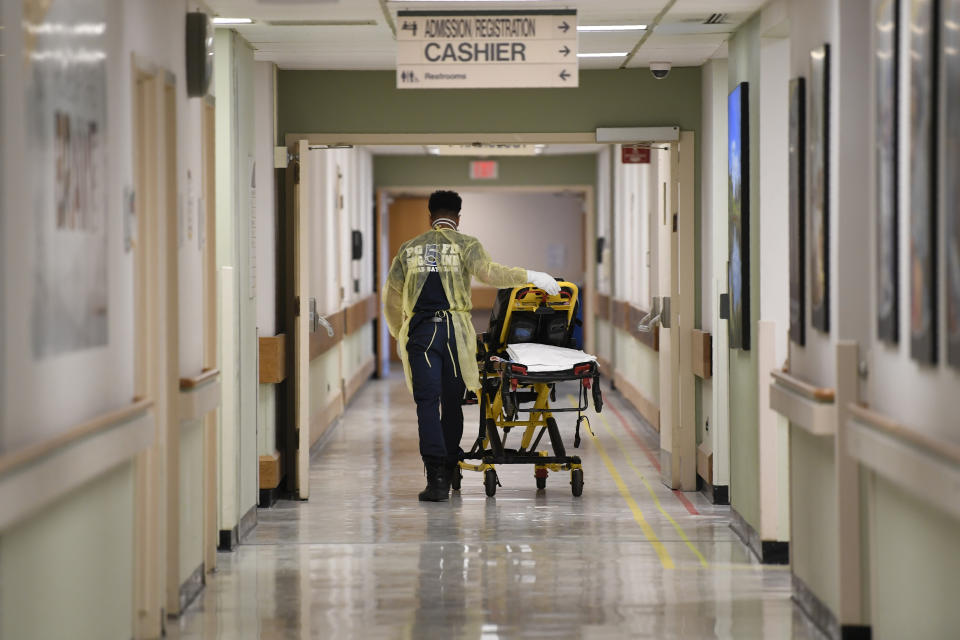Coronavirus response: 'Someone has to pay' for the rising U.S. health care costs
The coronavirus pandemic has already cost millions of U.S. jobs, and it could seriously drive up the cost of health care as well.
Although most insurance companies have announced they would be waiving the cost of coronavirus testing and treatment, the surge in hospital care required amid the pandemic raises the question of whether or not these costs will come back down the line.
“A lot of the talk right now [is] saying, ‘OK, we should reopen the country because it’s costing our economy and businesses, etc.,’” Dr. Bruce Y. Lee, a professor of health policy and management at CUNY School of Public Health, told Yahoo Finance. “But health care costs are quite significant. Someone has to pay for these things. So, really quantifying these numbers I think is going to be helpful for decision making.”

‘Many times they’ll pass along the cost’
There are currently over 840,000 cases of coronavirus in the U.S., making it the worldwide leader. Globally, there are over 2.6 million cases.
The number of cases in the U.S. could put a serious burden on the nation’s health care system, which has already received criticism for high costs. And with record unemployment claims sweeping through the nation, insurance companies are quickly facing demand like never before.
“Someone’s going to have to pay for it,” Lee said. “And so, if it’s insurance companies that have to pay for it, many times they’ll pass along the cost to increasing premiums or finding some way of supporting this.”
According to an actuarial brief from Covered California, premiums for 2021 could increase from anywhere between 4% to more than 40% as a result of COVID-19.
“What we pay in premiums is basically the cost of the people who are involved in the plans, their health spending in the year, plus the fee for administration and profit,” Matthew Rae, associate director of the Healthcare Marketplace Project at the Kaiser Family Foundation, previously told Yahoo Finance. “When you spend more in one year, that has a bearing on premiums the next year. It makes sense — if we spend a lot of money this year, that money comes from somewhere. Insurers collect that money through higher premiums.”
And according to a 2019 report from the Commonwealth Fund, employee premiums and deductibles have already been on the rise over the last few years.

Billions of dollars in costs
There is no doubt that increased health costs are occurring.
According to a new study from the CUNY Graduate School of Public Health and Health Policy, costs stemming from coronavirus-related treatment could range between $163.3 billion and $654 billion, depending on how much of the U.S. population gets infected with the coronavirus and actually displays symptoms.
If 20% of the population tested positive for COVID-19, that would cost over $163 billion in direct medical costs including only costs occurring during the course of infection. But if post-discharge costs are factored in, that raises the total to over $214.5 billion.
Half of the U.S. population infected would incur $408.8 billion in direct medical costs, and $536.7 billion when including post-discharge costs. And if 80% of the U.S. population were to test positive for COVID-19, it could cost upwards of $859 billion.

These costs factor in hospitalizations, ICU admissions, ventilators used, and hospital bed days. But it also takes into consideration people who display mild symptoms and may only need to pay for over-the-counter medications or a telehealth consult.
“The key thing here is we’re actually quantifying the amount of money, in different scenarios of course,” Lee said. “This gives people a sense, especially decision makers — like policy makers, business leaders, etc. — a better sense of how much it’s actually going to cost if different proportions of the population are infected.”
He continued: “Suddenly, you have this event that’s now adding hundreds of billions on top of that. As a country, as a society, we’re going to have to figure out: How are we going to pay for this? Who’s going to support all of these different types of costs? It shows the importance of trying to limit the percentage of people who actually get infected.”
The importance of social distancing
One way to limit the percentage of people infected is through social distancing, a measure that keeps people staying at home and limiting travel to essential tasks and duties, like grocery shopping or going to the pharmacy.
“The reason why we’re doing social distancing measures, in big part, is to reduce the burden on the health care system, and not only to not let the health care system get overwhelmed, especially on particular days, but also keep the health care costs down until we can find other ways of alleviating this pandemic that don’t necessarily involve just getting people exposed to the virus,” Lee said.

Lee added that reopening the economy too quickly would only drive up health care costs.
“When you reopen the economy or reopen business while the virus is still circulating,” he said, “then the risk is you actually have a surge in cases, because you’ll have people who are susceptible to the virus suddenly being reintroduced to mix with each other. And then, the virus could significantly spread.”
Until testing, contact tracing, and isolation measures can properly be put in place, social distancing is the primary form of intervention for slowing the virus, he said.
“The argument for reopening has been an economic argument, but you can’t just look at that side,” Lee said. “You have to look at the health care costs side too, because this will be a drain on the economy as well. And so, this is further support to wait until you have a lot more testing and can have a better idea of where the virus is spreading, who’s infected, and who could potentially be immune.”

And as for those who claim that COVID-19 is similar to the flu or other common infectious diseases, Lee said they need to at the very least consider the increased mortality rate and overall cost.
“This is further evidence this is not like the flu,” he said. “This is not like a cold. This is not like other types of more common infectious diseases. It’s a new virus that’s circulating that has significantly higher costs associated with it.”
Adriana is a reporter and editor for Yahoo Finance. Follow her on Twitter @adrianambells.
READ MORE:
Over 9 million Americans lost health insurance amid coronavirus pandemic, analysis finds
Coronavirus and the U.S. health insurance system is 'a recipe for disaster'
Coronavirus hospital bills: A look at the costs for Americans
Read the latest financial and business news from Yahoo Finance
Follow Yahoo Finance on Twitter, Facebook, Instagram, Flipboard, SmartNews, LinkedIn, YouTube, and reddit.
